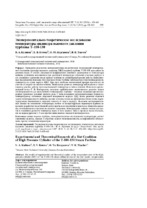| dc.contributor.author | Кудинов, В. А. | |
| dc.contributor.author | Котова, Е. В. | |
| dc.contributor.author | Курганова, О. Ю. | |
| dc.contributor.author | Ткачев, В. К. | |
| dc.coverage.spatial | Минск | ru |
| dc.date.accessioned | 2019-10-03T12:33:28Z | |
| dc.date.available | 2019-10-03T12:33:28Z | |
| dc.date.issued | 2019 | |
| dc.identifier.citation | Экспериментально-теоретическое исследование температуры цилиндра высокого давления турбины Т-100-130 = Experimental and Theoretical Research of a Hot Condition of High Pressure Cylinder of the T-100-130 Steam Turbine / В. А. Кудинов [и др.] // Энергетика. Известия высших учебных заведений и энергетических объединений СНГ. – 2019. – № 5. – С. 459-468. | ru |
| dc.identifier.uri | https://rep.bntu.by/handle/data/57537 | |
| dc.description.abstract | Приведены результаты экспериментально-теоретических исследований температур- ного состояния цилиндра высокого давления (ЦВД) паровой турбины Т-100-130 для одного из режимов пуска. С учетом зависимости коэффициента линейного расширения от температуры найдены удлинения находящихся при различной температуре отдельных участков корпуса и его суммарное удлинение после выхода турбины на стационарный режим работы. Выполнен- ные исследования показали, что в процессе пуска турбины наблюдается существенная разность температур по длине корпуса ЦВД. При этом наиболее интенсивный прогрев происходит на участке со второго по шестое сечения. Наибольшая разность температур наблюдается в стаци- онарном режиме работы при максимальной температуре в пятом сечении. Используя ортого- нальный метод Л. В. Канторовича, получено приближенное аналитическое решение задачи теплопроводности для двухслойной стенки (корпус турбины – тепловая изоляция) при неодно- родных граничных условиях третьего рода. С использованием экспериментальных данных по температурному состоянию наружной поверхности корпуса ЦВД путем решения обратной задачи теплопроводности найдены средние за период пуска коэффициенты теплоотдачи, харак- теризующие интенсивность передачи теплоты от пара к корпусу. На основе эксперименталь- ных данных по изменению температуры любого из контролируемых параметров турбины во времени разработан теоретический метод прогноза ее изменения в некотором диапазоне време- ни, отсчитываемом от времени последнего измерения. Использование данного метода для про- гноза изменения разности температур верха и низа корпуса ЦВД в процессе пуска показало, что на период времени 3–5 мин прогноз выполняется с высокой достоверностью. | ru |
| dc.language.iso | ru | ru |
| dc.publisher | БНТУ | ru |
| dc.title | Экспериментально-теоретическое исследование температуры цилиндра высокого давления турбины Т-100-130 | ru |
| dc.title.alternative | Experimental and Theoretical Research of a Hot Condition of High Pressure Cylinder of the T-100-130 Steam Turbine | ru |
| dc.type | Article | ru |
| dc.identifier.doi | doi.org/10.21122/1029-7448-2019-62-5-459-468 | |
| local.description.annotation | The results of experimental and theoretical studies of the temperature state of the highpressure cylinder (HPC) of the T-100-130 steam turbine for one of the start modes are presented. Taking into account the dependence of the coefficient of linear expansion on the temperature, the elongations of the individual sections of the casing under different temperatures and its total elongation after the turbine operation starts to correspond to the stationary operation mode have been found. The studies have shown that in the process of actuation the turbine there is a significant difference in temperature along the length of the HPC casing. In this case, the most intense heating occurs in the area from the second to the sixth section. The greatest temperature difference was observed in stationary operation at maximum temperature in the fifth section. Using the orthogonal method of L. V. Kantorovich, an approximate analytical solution of the thermal conductivity problem for a two-layer wall (turbine casing – thermal insulation) under inhomogeneous boundary conditions of the third kind is obtained. With the use of experimental data on the temperature state of the outer surface of the casing of the HPC by solving the inverse problem of thermal conductivity, the average heat transfer coefficients for the actuation period characterizing the intensity of heat transfer from steam to the casing have been found. On the basis of experimental data on the temperature change of any of the controlled parameters of the turbine over time, a theoretical method for predicting its change in a certain time range from the time of the its last measurement has been developed. The use of this method to predict the change in the temperature difference between the top and bottom of the HPC casing during the actuation showed that for a period of time equal to 3–5 minutes the forecast is fulfilled with high reliability. | ru |

